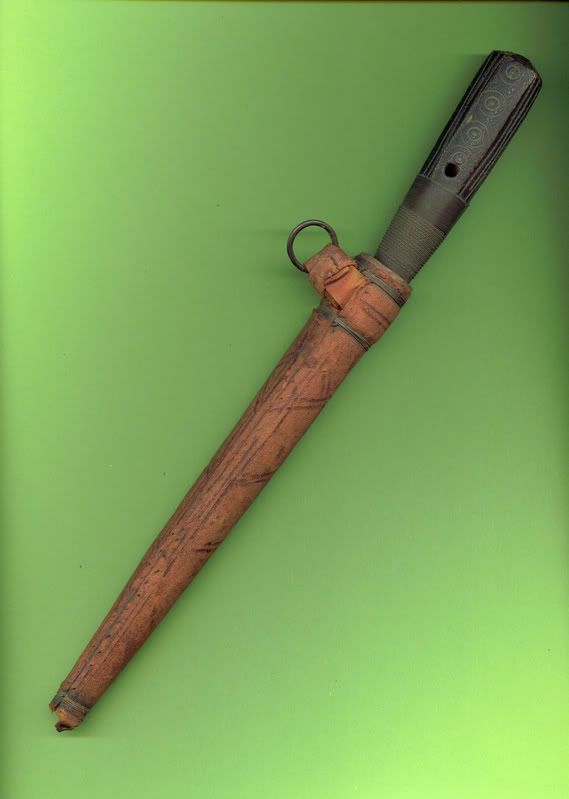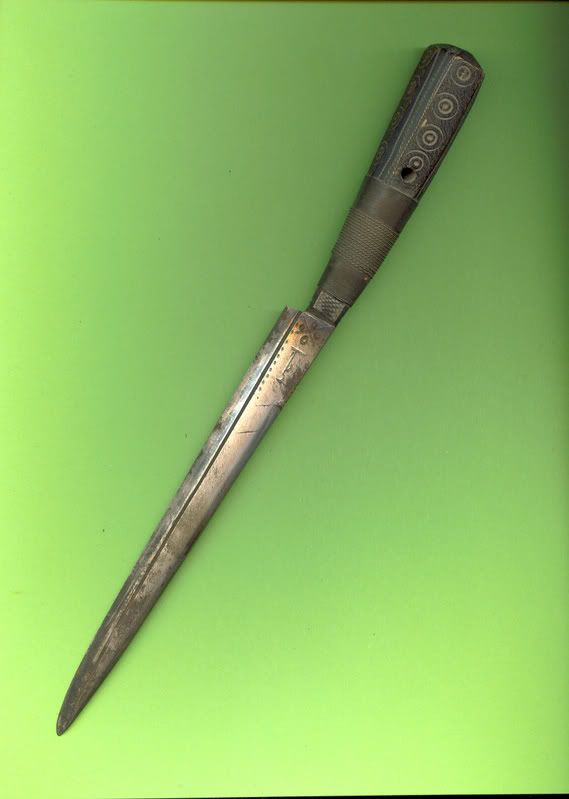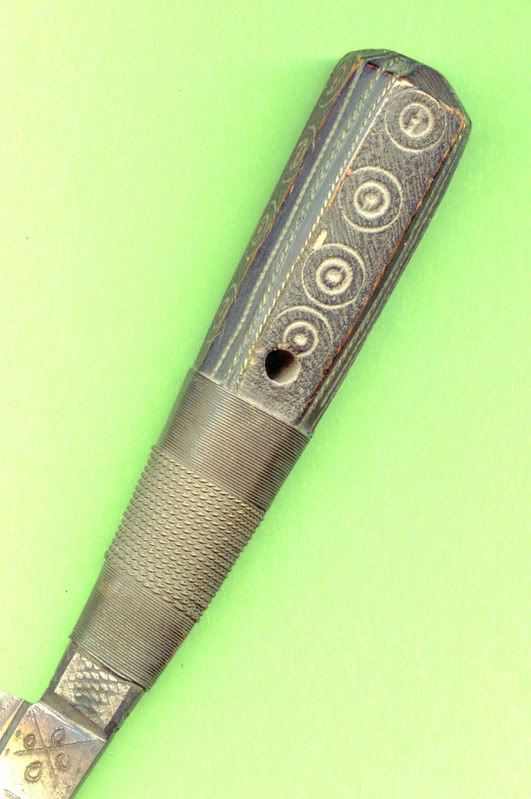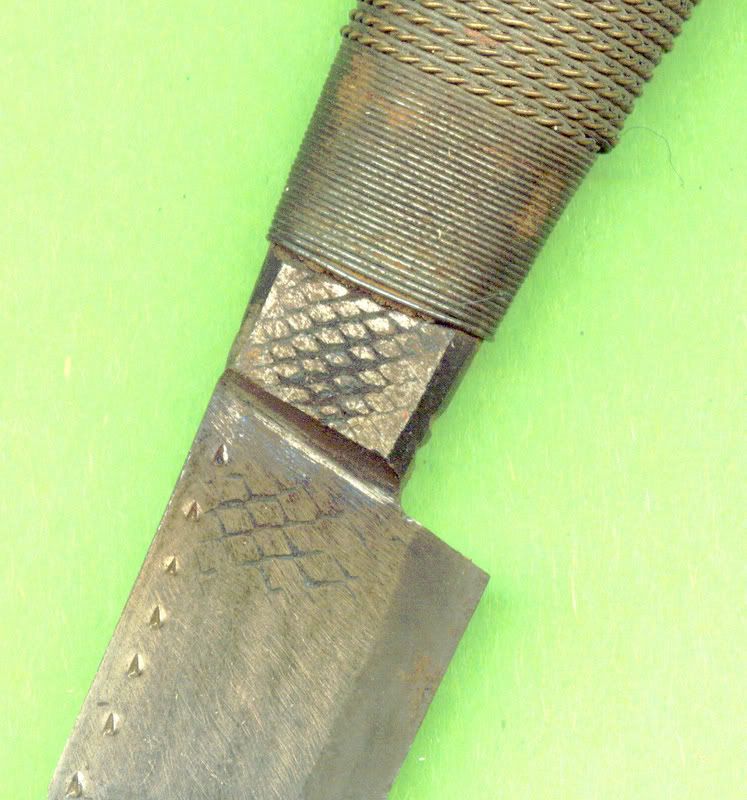
 |
|
|
|
|
#1 |
|
Member
Join Date: Dec 2004
Location: Sint-Amandsberg (near Ghent, Belgium)
Posts: 830
|
I recently found this knife on ebay. From time to time, similar knives are offered, mostly of a poor quality. But when I received this particular piece, I noticed it was really well made.
It is a Bou-saâdi knife from the town-oasis Bou-saâda in Algeria. Here a link to situate this town : http://lexicorient.com/e.o/bou-saada.htm The knife comes with a simple scabbard of two pieces of wood, covered with some kind of leather. The handle of my piece is also made of wood, with some copper winding as decoration. What's especially interesting is the blade. It's very well forged and razorsharp. Upon examining this piece, I found out that it was probably made from a file (look at the last pic). I guess it dates from the Algerian War of Independence (1954–62). Probably it was brought back by a French soldier. Measurements : total length in sheath : 30 cm length of blade : 18,5 cm width of blade near the handle : 2,2 cm the back of the blade near the handle is 6 mm thick    
|
|
|

|
|
|
#2 |
|
Member
Join Date: Jan 2006
Location: Kent
Posts: 2,658
|
Hi Freddy,
I think I have your knife's brother, also made from a file . My blade is 18cms long, approx. 6mm thick blade . Very similar decoration, very sharp and well made.....unfortunately no sheath  . .So is mine a Bou-saâdi knife ? |
|
|

|
|
|
#3 |
|
Member
Join Date: Dec 2004
Posts: 182
|
Both nice Khodmis !
 I have several,and as far as I can tell all of mine are made from files,I wonder where all of them came from? 
|
|
|

|
|
|
#4 |
|
Member
Join Date: Dec 2004
Location: Sint-Amandsberg (near Ghent, Belgium)
Posts: 830
|
Katana, Justin,
I think that it's far easier using steel from files than actually making your own steel. As to the shape of these knives, yes they are all quite similar. I see that on Katana's knife, some copper dots are added. Nice touch. My guess is that this kind of knife is a functional piece, with a simple design. I've seen examples with were much simpler in decoration, but still with a sharp blade. Recently, a bou-saâdi knife with a curved handle was offered on ebay. Perhaps different types exist, who knows ? |
|
|

|
|
|
#5 |
|
Member
Join Date: Jan 2006
Location: Kent
Posts: 2,658
|
Freddy,
I agree these are functional ....not only because of the thickness/sharpness of the blade but also the design of the handle. Mine (when looking down on the spine of the knife) has one side of the handle (the left side) in line with the blade....the right side has a different angle making it fatter than the right. It seems that mine is designed for a right-handed person ...as it sits nicely in the palm and the blade points straight forward Using it left-handed puts the blade at a slight angle and is not as comfortable. Last edited by katana; 11th February 2007 at 01:57 AM. |
|
|

|
|
|
#6 |
|
Member
Join Date: Jul 2005
Location: Toronto, Canada
Posts: 1,242
|
Hello,
I recently stumbled apon a book about Algeria from the turn of the century (20th that is) It showed the type of knives being produced in Bou Saada, and it was the straight variety only, as the ones shown in this thread. The curved type are recent and are made for the tourist market. The blade geometry and the excessive decorations on the blade point to this. Here is mine: http://www.vikingsword.com/vb/showthread.php?t=2140 And an ebay one: http://www.vikingsword.com/vb/showthread.php?t=3849 I'd really like to get the authentic variety, I thoroughly dislike my tourist one  Hi David, I think the misalignment of the handle on your example is purely a result of simple craftsmanship. I think the tang was not fitted precisely, only "crudely". I also think that distinctions of right-handed or left-handed may not apply to knife fights, as a fighter would change from one hand to another depending on the situation. Being limited to one hand only would be a terrible disadvantage I think. Emanuel |
|
|

|
|
|
#7 |
|
Member
Join Date: Jan 2006
Location: Kent
Posts: 2,658
|
Hi Freddy,
I also noticed that the remaining file teeth 'pattern' is visible in the same areas on each knife. The blade is quite thick , so if a 'file' knife was undesirable they could easily remove the evidence (teeth pattern) by making the blade slightly thinner. Could it be like a 'quality' mark ....so that you could easily see what the blade was made from.  If that is the case I can only assume that 'file' knives were desirable by the locals. If that is the case I can only assume that 'file' knives were desirable by the locals.
|
|
|

|
|
|
#8 | |
|
Member
Join Date: Dec 2004
Posts: 1,712
|
Quote:
I have an Afghan sabre that follows the same right handed approach as well. I dont think its an unusual concept, I think I have seen similar in Nazi daggers? Whether historicaly this is for hand fit or perhaps just greater comfort in a piece worn against the body I have no idea. But to me it seems to serve both functions. Spiral |
|
|
|

|
 |
| Thread Tools | Search this Thread |
| Display Modes | |
|
|